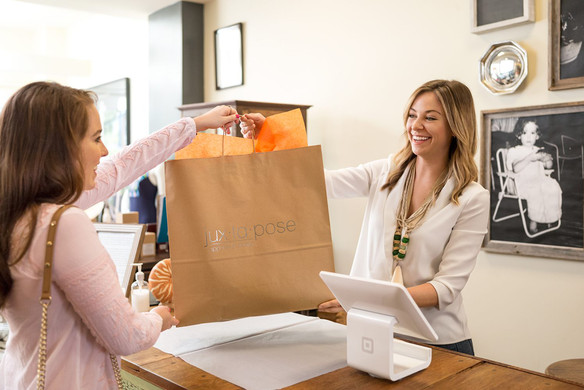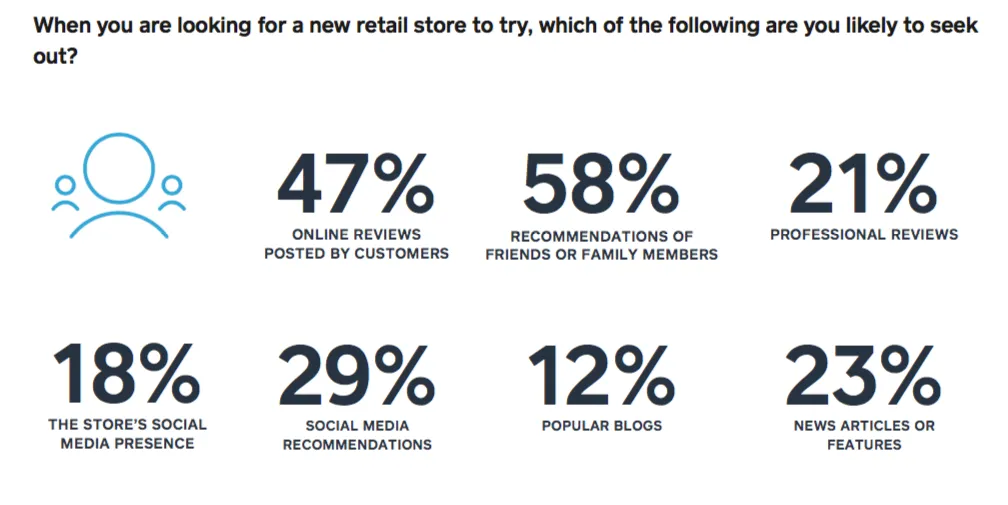There are plenty of choices for consumers to choose from when it comes to a retail store, whether that’s online or in person at a brick-and-mortar store. This means that your retail store’s success depends not only on its products and customer service but also your ability to reach (and retain) new customers.
To do that, you first need to know how people discover retailers. So we surveyed 1,800 U.S. consumers to learn just that. (We also asked consumers why they would decide to try a retail store and then recommend it to their friends. To go into the survey findings in more depth, read our ebook.)
Personal recommendations and online reviews rule.
When it comes to finding a new retail store, personal recommendations are key. Nearly two-thirds of people surveyed said they are most likely to ask friends and family for a recommendation, and a personal recommendation is important to some degree for 92 percent of respondents.
The second-most preferred method of finding a retail store is through an online review posted by customers. Interestingly, nearly half of the people surveyed say they trust other customers’ reviews more than they trust reviews written by professionals.
The content of those reviews is important, too. Seventy-seven percent of people said it’s very or extremely important that a reliable review include specific details about the products or services someone purchased.
Reviews aren’t from where you’d think.
The biggest group of consumers (28 percent) say that Google Reviews is their favorite source for online reviews.
Google Reviews is built into the online discovery process, which could explain this preference. Whenever consumers perform a search on Google, they see Google Reviews. If a consumer wants to find the best children’s clothing shop in the city, for example, and googles it, the first thing that comes up at the top of the results page is a list of local children’s clothing stores with star ratings from customers.
After Google Reviews, the next favorite online review sites are Facebook and Yelp. And consumers are checking these online platforms regularly for recommendations — over 20 percent reported looking up reviews on a website or app a few times per week, while almost a quarter reported checking a few times per month.
How often do consumers look up reviews on a website or app?

Facebook is the favorite social media platform for finding retail stores.
Almost 75 percent of consumers said Facebook is their favorite social platform to find retail stores. Behind Facebook is Instagram, Twitter, and then Snapchat.
Additionally, 40 percent of people have become interested in a retail store after seeing a picture someone posted on Facebook or Instagram — this goes up even higher for younger generations like millennials and Xennials.
People use social media proactively to discover retail stores.
Consumers aren’t just scrolling through social media and coming across retail locations. Some are proactively asking their networks for recommendations (Facebook even has a special feature for this now).
Nineteen percent of respondents ask for retail recommendations via social media a few times per month. But 38 percent ask for retail recommendations on social media even more often than that, and 12 percent ask for recommendations more than once a day.
Now that you know how people are discovering retailers, you’re ready to put together a plan to make your business more discoverable. Here are some tactics to ensure new customers keep coming through the door:
Ramp up online reviews.
Consumers trust their peers, so online reviews are important to draw in new customers. The more reviews that are available, the more information that potential clients have about your business and the products and services you offer.
To ensure a strong presence, stay active on review sites. Respond to reviews, whether they’re positive or negative. It’s important to let customers know that they are heard, and that you genuinely appreciate them taking the time to sing your praises or show you how to improve.
Learn more about how to harness the power of customer reviews with this webinar we hosted with Yelp.
Have a solid social media presence.
Building your brand on social media is an important aspect of marketing, especially when it comes to retail. Create a strong presence online, and make sure you (and/or your employees) update it regularly.
To help you get started, you can find advice for building your brand on social media from Square’s expert here, learn our favorite tips for Instagram, and discover how to get creative with Stories and live video.
Optimize for SEO.
You may not be able to pick up your retail store and move it, but knowing that location is important to potential customers means that you should make sure you come up in local searches.
Doing a bit of local search engine optimization (SEO) will ensure that you come up in online searches, and it doesn’t need to be complicated or involve spending thousands of dollars on an SEO agency. One easy way to start is to make sure you mention your location on your website as well as in your titles and meta tags (a simple plugin like Yoast can help you with this).
And if you haven’t already done so, make sure to claim your retail store on Google My Business, which acts like a huge directory. There are lots of other directories and online listings you should sign up with, too, like Yelp, Bing, Foursquare, and local.com.
Request feedback.
How are you doing? When customers know that you take their feedback seriously, they know you care. Set out written feedback cards, or implement a POS that requests feedback from your customers. You might also ask your employees to informally let you know of any feedback that customers give.
How does this spur discovery? Well, the happier your customers are, and the more responsive you are to feedback, the more likely you are to have customers be your brand evangelist to their friends and family.
![]()












